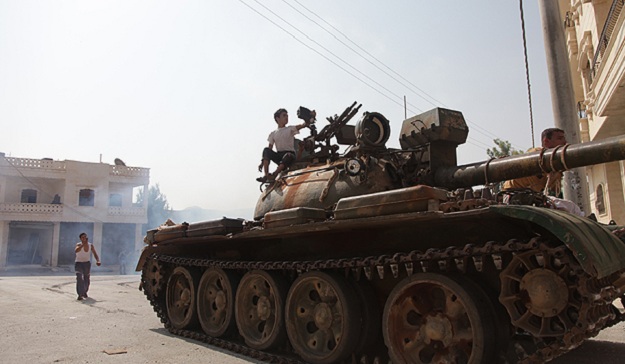
At its root, the Syrian imbroglio is sectarian. It is the result of the age-old Sunni-Shia conflict and the divide-and-rule policy of imperialists. It therefore parallels the turmoil in the Indian subcontinent in 1947 at the end of the 140-year-old British Raj. The eight-century long tensions between majority Hindus and minority Muslims culminated in a communal bloodbath which subsided only after Britain divided its colony into India and Pakistan. The partition claimed nearly 800,000 lives, and led to the transfer of 12 million people across the newly demarcated international border.
Now, considering the intensity of violence in Syria, the level of armed rebels’ organisation and the duration of fighting, the International Committee of the Red Cross ruled on 15 July that the country was in the midst of a civil war. Of the 23 million Syrians, 15.5 million are Sunni whereas levers of power are held largely by 3 million Alawites, a sub-sect within Shia Islam.
Several scenarios for Syria can be categorised as clear-cut or protracted. The most optimistic and least violent one has Syrian President Bashar al-Assad transferring power to a transitional authority led by his deputy until fresh elections are held. This proposal has the backing of the USA, Britain and France, and would satisfy the armed Syrian opposition which refuses to deal with Assad under any circumstances.
Another clear-cut scenario would entail the loyalist Syrian military defeated by the rebel Free Syrian Army (FSA). The FSA can achieve this by ‘controlled demolition’ of the Assad regime, stripping it of one powerful layer after another, until it is left with the exclusively Alawite militia nicknamed Shabiha (‘ghosts’ in Arabic). But such a process will not unfold as planned when almost 100 rebel formations are fighting the government.
Moreover, such a multifarious coalition, united only by its hatred of the Alawite-dominated regime, will struggle to cope with the collapse of the centralised Baathist state. The post-Assad period will witness ethnic cleansing of Alawites and their close allies, Christians, as well as clashes between various anti-Assad militias for supremacy, creating a fertile ground for al Qaeda-affiliated groups to flourish as they did in post-Saddam Iraq.
A protracted scenario is more likely because the FSA is unable to consolidate its gains, mainly because it lacks popular support in major cities – as has been in the case in Damascus and Aleppo since mid July. Lacking a central command, sufficient ammunition and anti-aircraft missiles, the rebels are being squeezed out of the neighbourhoods of the two prime cities by the regime’s air force, armour and infantry. Whereas the regime’s authority has been contested in Damascus and Aleppo, it remains unchallenged in the coastal plain between the al-Alawiyin Mountains, running north to south, and the Mediterranean.
Tartus, the second largest Syrian port, is the site of Russia’s sole naval base in the Mediterranean. By gradually shifting its power base to the coastal plain, the Assad regime could continue a protracted civil war with assistance from Iran and Russia. Already, besides using the seaports to ferry arms and other aid to Syria, Iran is using the unguarded Iraqi air space to shore up the Assad government.
The end of such conflict can be achieved by carving out an Alawite state between Lebanon and Turkey. This could involve population exchange amid violence as happened in British India in 1947, with Hindus and Sikhs moving out of West Pakistan into East Punjab and Delhi, and the Muslims from the other side migrating in the opposite direction. Already the Sunnis are leaving the coastal plain to take refuge in Sunni Turkey or to join relatives in the hinterland.
During their rule in India, the British encouraged the rise of the All India Muslim League to counter the influence of the nationalist Hindu-dominated Indian National Congress (INC). The League gained much ground during the Second World War by backing the Allies while INC leaders were jailed for launching the anti-British Quit India movement in 1942. Within seven years of demanding a Muslim homeland in the subcontinent, it achieved its aim.
During its Mandate over Syria from 1923, France shored up minority Alawites – detested by Sunnis who resisted foreign rule. Crucially, it gave preference to Alawite applicants at the military academy in Damascus. Later when it moved the academy to Homs and set up special forces units, it continued this policy. The Homs Military Academy played a leading role after Syria’s independence in 1946, with many of its Alawite graduates becoming generals and mounting a series of coups, the last one led by Hafez al-Assad – a native of an Alawite village near Latakia – in 1971. He co-opted fellow cadet Mustafa Tlass, a Sunni. While reserving top senior civilian and military posts for Sunnis, he ensured that officer corps of the military, police and intelligence services was dominated by fellow Alawites.
Bashar’s more recent privatisation policy enriched the Sunni business class in large cities and that strengthened the regime’s non-Alawite base but the sectarian composition of the military remained. Of the 300,000 soldiers, two thirds are professionals, with 70 percent being Alawite. They know that if the Assad regime collapses, they could be butchered by Sunni victors. They are therefore fighting as much for their own survival as the regime’s. A viable alternative for them is retreat to an Alawite-majority zone where Christians, close allies of the Baathist regime, would be welcome. Together, the two minorities form a quarter of the Syrian population, just as the Muslims in British India did in the mid-1940s.





